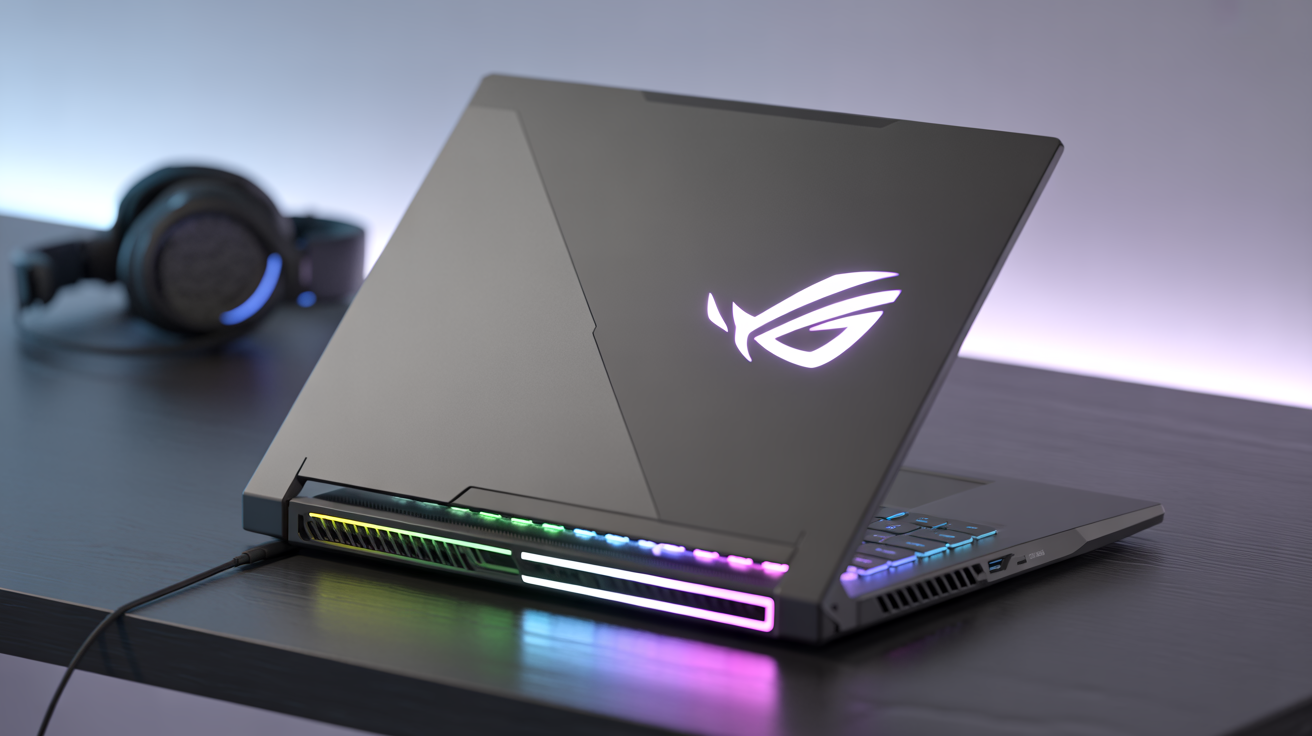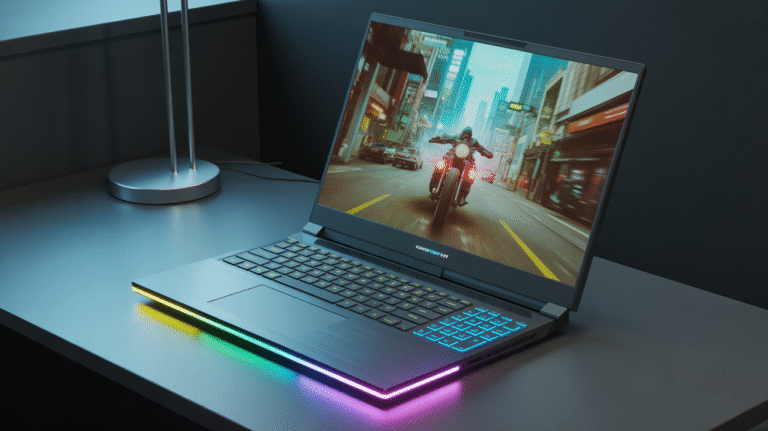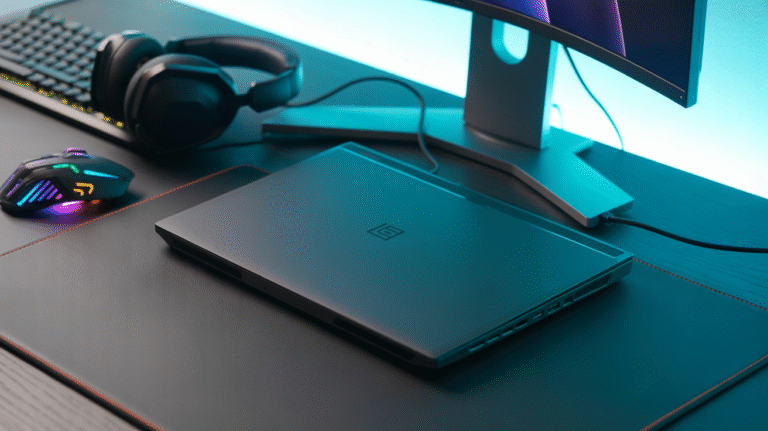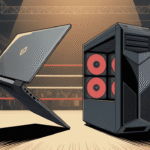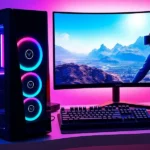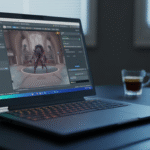Choosing a gaming laptop can feel overwhelming. Unlike standard laptops, gaming machines require a delicate balance of powerful components packed into a portable form factor. This guide breaks down the most critical specifications to help you understand what truly makes a good gaming laptop and how to select the right one for your needs.
A gaming laptop is designed specifically to handle the demands of modern video games, which require significant processing power and graphical capabilities. They are distinct from regular laptops due to their high-performance components, advanced cooling systems, and often more robust build quality. The challenge lies in fitting desktop-level performance into a portable device, which impacts everything from price to battery life.
Core Performance: The Dynamic Duo

At the heart of any gaming laptop are the two components responsible for processing and rendering the game world: the CPU and the GPU. Their performance dictates how smoothly and at what quality settings games will run. Focusing on these two is paramount when evaluating any gaming machine.
CPU (Central Processing Unit): The Brains
The CPU is the central processor, managing all the calculations and instructions that aren’t handled by the GPU. In gaming, it handles things like AI, physics, game logic, and preparing data for the GPU. A strong CPU prevents bottlenecks, ensuring the GPU isn’t left waiting for data.
Modern CPUs from Intel (Core i5, i7, i9) and AMD (Ryzen 5, 7, 9) offer multiple cores and threads, which are beneficial for games that utilize parallel processing and for multitasking (like running Discord or streaming software in the background). Understanding processor generations and clock speeds (measured in GHz) helps gauge performance, with higher numbers generally indicating better performance within the same generation. A good gaming laptop needs a CPU that can keep up with its dedicated graphics card.
GPU (Graphics Processing Unit): The Muscle
The GPU is arguably the single most important component for gaming performance. It is solely dedicated to rendering the graphics you see on screen – everything from character models and textures to complex lighting effects and visual physics. A more powerful GPU allows you to play games at higher resolutions, higher graphical settings, and achieve higher frame rates.
Gaming laptops feature dedicated graphics cards, typically from NVIDIA (GeForce RTX/GTX series) or AMD (Radeon RX series). These are separate, powerful chips with their own video memory (VRAM). VRAM is crucial as it stores graphical data like textures and frame buffers; more VRAM allows for higher resolution textures and complex scenes without performance hitches, especially at resolutions above 1080p. Features like Ray Tracing (realistic lighting and shadows) and technologies like NVIDIA DLSS and AMD FSR (AI-powered upscaling to boost performance) are also important considerations, especially with modern titles.
Memory and Storage: Speed and Capacity

Beyond the core processing units, how the laptop handles data is key. RAM and storage speed significantly impact loading times, multitasking, and overall system responsiveness, which are vital for a smooth gaming experience.
RAM (Random Access Memory): Multitasking Power
RAM acts as temporary storage for the data the CPU and GPU are currently working with. For gaming, having sufficient RAM is essential for running the game itself, the operating system, and any background applications simultaneously without slowdowns. 16GB of RAM is the recommended minimum for a modern gaming laptop to handle most games comfortably.
While 16GB is a good starting point, 32GB can be beneficial for heavy multitasking, future-proofing, and specific games that are RAM-intensive. The speed of the RAM (measured in MHz) also plays a role, though typically less significant than capacity and the CPU/GPU choice. Faster RAM can provide a small performance boost in certain scenarios.
Storage: Fast Access and Space
How quickly your games and applications load depends heavily on your storage type. For gaming, Solid State Drives (SSDs) are essential. They offer dramatically faster read and write speeds compared to traditional Hard Disk Drives (HDDs). This means significantly faster boot times for the laptop, quicker loading times for games and levels, and smoother in-game asset streaming.
NVMe SSDs are the fastest type of SSD, connecting directly to the motherboard via a PCIe slot, offering superior performance over SATA SSDs. While HDDs offer larger capacity for a lower price, they are much slower and are best used for bulk storage of less-accessed files or older games. Many gaming laptops feature a combination: a fast NVMe SSD for the operating system and frequently played games, and a larger HDD for other data. Consider storage capacity carefully, as modern games can take up significant space.
The Display: Your Window into the Game

The display is your primary interface with the game, and its quality and specifications directly impact how the game looks and feels. Key factors include resolution, refresh rate, and response time.
Resolution: Detail and Sharpness
Resolution refers to the number of pixels on the screen (e.g., 1920×1080 for 1080p, 2560×1440 for 1440p, 3840×2160 for 4K). Higher resolutions offer sharper, more detailed images but require significantly more GPU power to render games smoothly. 1080p (Full HD) is common for gaming laptops as it balances visual detail with achievable frame rates, especially on smaller screens.
1440p (QHD) offers a noticeable step up in sharpness and is becoming more popular in mid-range to high-end gaming laptops. 4K (UHD) provides the ultimate detail but typically requires the most powerful GPUs to run modern games at playable frame rates. It’s crucial to match the display resolution to the laptop’s GPU capabilities; a powerful GPU paired with a 1080p screen will achieve very high frame rates, while a weaker GPU with a 4K screen will struggle.
Refresh Rate: Smoothness of Motion
The refresh rate, measured in Hertz (Hz), indicates how many times per second the display can update the image. A standard display is typically 60Hz. Gaming displays often feature high refresh rates like 120Hz, 144Hz, 240Hz, or even higher. A higher refresh rate results in smoother motion, reduced motion blur, and a more responsive feel, which is particularly beneficial in fast-paced and competitive games.
For example, a 144Hz display can show up to 144 frames per second, provided the GPU can render them. This creates a much more fluid visual experience than a 60Hz screen. While 60Hz is acceptable for slower-paced games, most serious gamers prefer 120Hz or higher.
Response Time: Avoiding Ghosting
Response time, measured in milliseconds (ms), is the time it takes for a pixel to change color. A lower response time reduces motion blur and ghosting (trailing artifacts behind moving objects), especially in fast-moving scenes. Look for displays with response times of 5ms or less for a cleaner image during rapid action.
Panel Type: Colors and Viewing Angles
The panel technology affects color accuracy, contrast, and viewing angles.
- IPS (In-Plane Switching) panels are popular for gaming laptops as they offer excellent color accuracy, good contrast, and wide viewing angles. They are generally preferred for their overall image quality.
- TN (Twisted Nematic) panels typically have faster response times and higher refresh rates but suffer from poorer color reproduction and narrow viewing angles. They are sometimes found in budget or older gaming laptops focused purely on speed.
- OLED (Organic Light-Emitting Diode) panels offer exceptional contrast, true blacks, and vibrant colors but are typically more expensive and less common in gaming laptops, though this is changing.
Adaptive Sync Technologies (G-Sync/FreeSync): Eliminating Screen Tearing
Screen tearing occurs when the display updates while the GPU is sending a new frame, resulting in horizontal breaks in the image. Technologies like NVIDIA G-Sync and AMD FreeSync synchronize the display’s refresh rate with the GPU’s frame rate, eliminating tearing and reducing stuttering. This results in a much smoother and more enjoyable visual experience, especially when frame rates fluctuate.
Cooling System: Sustaining Performance

High-performance components like powerful CPUs and GPUs generate significant heat. An effective cooling system is critical for a gaming laptop. Without adequate cooling, components will overheat and activate thermal throttling, which reduces performance to prevent damage.
A good cooling system typically involves multiple fans, heat pipes that transfer heat away from the components, and strategically placed vents. The design and efficiency of the cooling system directly impact how well the laptop can sustain peak performance during long gaming sessions. While testing actual thermal performance can be difficult before purchase, reviews often highlight how well a laptop manages heat and maintains performance under load.
Keyboard and Touchpad: Input and Comfort

While many gamers use external peripherals, the integrated keyboard and touchpad are still important for general use and portability. A good gaming laptop keyboard should be comfortable for typing and responsive for gaming.
Look for keyboards with decent key travel (how far a key presses down) and tactile feedback. Anti-ghosting and N-key rollover are crucial features that ensure multiple key presses are registered correctly, preventing input errors during complex maneuvers. Keyboard backlighting (often customizable RGB) is common, useful for gaming in low light, and adds to the aesthetic. While the touchpad quality is less critical for gaming (as a mouse is preferred), a smooth and responsive one improves the overall user experience.
Connectivity: Ports and Networking

Connectivity options determine what peripherals you can connect and how reliably you can connect to the internet. A good gaming laptop should offer a variety of essential ports.
Look for multiple USB ports (including both Type-A and the smaller, reversible Type-C). Thunderbolt (often integrated with USB-C) offers extremely fast data transfer and can support external GPUs or multiple high-resolution displays. HDMI and DisplayPort are necessary for connecting external monitors. An Ethernet port is crucial for a stable, low-latency wired internet connection, which is vital for online gaming. For wireless connectivity, support for the latest Wi-Fi standards (Wi-Fi 6 or Wi-Fi 6E) is highly beneficial for faster speeds and improved performance on congested networks. Bluetooth is standard for connecting wireless peripherals like headsets or controllers.
Battery Life and Portability: The Mobile Factor

Gaming laptops are powerful, but this power comes at the cost of battery life, especially when gaming. While manufacturers might advertise several hours of battery life, expect significantly less when running demanding games (often 1-2 hours). The battery is more for general productivity or light tasks when away from a power outlet.
Consider the laptop’s weight and dimensions if portability is a major concern. Larger, more powerful gaming laptops tend to be heavier and bulkier. The build materials (plastic, aluminum, magnesium alloy) affect both durability and weight. While not as portable as ultrabooks, modern gaming laptops are becoming more slim and manageable.
Audio: Speakers and Headphone Jacks

While most serious gamers use headphones for immersive sound and communication, the quality of the integrated speakers and headphone jack is still worth considering. Some gaming laptops feature surprisingly good speakers, often enhanced by audio software like Nahimic or Dolby Atmos. Ensure there’s a standard 3.5mm headphone jack for compatibility with most gaming headsets.
Build Quality and Aesthetics

The construction of the laptop impacts its durability and feel. Materials like aluminum offer a premium feel and better rigidity than plastic. Pay attention to the hinge design, as it’s a common point of wear and tear. Aesthetics, including the design, lighting (often customizable RGB lighting zones), and overall finish, are subjective but contribute to the gaming laptop experience.
Upgradeability
The ability to upgrade components can extend the lifespan and value of a gaming laptop. Most gaming laptops allow users to easily add or replace RAM modules and install additional or larger SSDs/HDDs. Check reviews or manufacturer specifications to confirm which components are user-upgradeable. The GPU and CPU are typically soldered to the motherboard and cannot be upgraded.
Operating System

The vast majority of PC games are designed for and run best on Windows. Ensure the gaming laptop comes with a recent version of Windows (currently Windows 11), which includes features and optimizations relevant to gaming.
Price vs. Performance: Finding the Balance

Gaming laptops represent a significant investment, and there’s a wide range of options across various price points. It’s crucial to set a budget and prioritize the specifications that matter most for the games you want to play and the experience you desire.
- Entry-level gaming laptops (often with GTX graphics or lower-tier RTX/Radeon cards) are suitable for 1080p gaming at medium settings.
- Mid-range laptops (with mid-tier RTX/Radeon cards) can handle 1080p at high/ultra settings or sometimes 1440p at lower settings.
- High-end laptops (with top-tier RTX/Radeon cards) are designed for 1440p or 4K gaming at high/ultra settings and high refresh rates.
Understanding this hierarchy helps you balance desired performance with your financial constraints. Don’t overspend on features you won’t use, but also ensure the core components are powerful enough for your needs.
Additional Features (Optional but Nice)
Beyond the core specs, some features are nice additions but not strictly essential for gaming performance:
- Webcam quality: Important if you plan to stream or video conference.
- Biometric login: Features like fingerprint readers or facial recognition add convenience.
- Software suites: Manufacturers often include software for monitoring system performance, customizing RGB lighting, or optimizing network traffic for gaming.
Conclusion: Making Your Decision
Choosing the right gaming laptop involves understanding the role of each key component and how they work together. Prioritize the GPU and CPU first, as they are the biggest determinants of gaming performance. Follow this by considering the display specifications (resolution and refresh rate) that match the GPU’s capabilities and your preferences. Sufficient RAM (16GB+) and a fast SSD are essential for a smooth experience.
Don’t overlook the importance of the cooling system for sustained performance. Finally, balance these technical specifications with factors like portability, build quality, and your budget. By carefully considering these key specs, you can find a gaming laptop that delivers the performance and experience you need to dive into your favorite virtual worlds.
Frequently Asked Questions (FAQs)
- Q: What’s more important for gaming, the CPU or GPU? A: While both are important, the GPU (Graphics Processing Unit) is generally more critical for gaming performance. The GPU is responsible for rendering the visuals, and a more powerful GPU will directly translate to higher frame rates and better graphics quality. The CPU handles game logic, AI, and physics, and a strong CPU is still needed to avoid bottlenecks, but the GPU is the primary driver of visual performance.
- Q: How much RAM do I need for a gaming laptop?A: 16GB of RAM is the recommended minimum for modern gaming. Some games and multitasking scenarios can benefit from 32GB, but 16GB is generally sufficient for a good gaming experience.
- Q: Is a 144Hz display worth it for gaming?A: Yes, a 144Hz display offers a significantly smoother and more responsive gaming experience compared to a standard 60Hz display. The higher refresh rate reduces motion blur and allows you to see fast-paced action more clearly, which can be a competitive advantage in some games.
- Q: What is the ideal screen resolution for a gaming laptop?A: The ideal resolution depends on your budget and the laptop’s GPU. 1080p (Full HD) is a good balance of performance and visual quality for most gaming laptops. 1440p (QHD) offers a sharper image but requires a more powerful GPU. 4K (UHD) provides the most detail but demands the most powerful and expensive hardware.
- Q: Should I choose an SSD or HDD for my gaming laptop?A: An SSD (Solid State Drive) is essential for a gaming laptop. SSDs offer significantly faster loading times for games, the operating system, and applications compared to traditional HDDs. NVMe SSDs are even faster than SATA SSDs. Using a combination of a smaller, faster SSD for the OS and games, along with a larger HDD for general storage, is an option to balance speed and capacity.
- Q: How important is the cooling system in a gaming laptop?A: The cooling system is extremely important. High-performance components generate heat, and without adequate cooling, the laptop will experience thermal throttling, which reduces performance to prevent overheating. Look for laptops with well-designed cooling systems that include multiple fans, heat pipes, and strategically placed vents.
- Q: Can I upgrade the components in a gaming laptop?A: You can typically upgrade the RAM and storage in most gaming laptops. However, the GPU and CPU are usually soldered to the motherboard and cannot be upgraded. Check the laptop’s specifications and reviews to confirm which components are user-upgradeable before purchasing.
- Q: What are G-Sync and FreeSync, and do I need them?A: G-Sync (NVIDIA) and FreeSync (AMD) are adaptive sync technologies that synchronize the display’s refresh rate with the GPU’s frame rate. This eliminates screen tearing and reduces stuttering, resulting in a smoother visual experience. While not strictly necessary, they significantly improve the gaming experience, especially when frame rates fluctuate.
- Q: How much should I expect to spend on a decent gaming laptop?A: The cost of a gaming laptop varies widely depending on the specifications. Expect to spend at least $800-1000 for an entry-level gaming laptop** capable of running modern games at 1080p with medium settings. **Mid-range laptops typically cost between \1200-1800∗∗,offeringbetterperformanceandfeatures.∗∗High−endgaminglaptopscancost1800∗∗,offeringbetterperformanceandfeatures.∗∗High−endgaminglaptopscancost2000 or more, providing the best possible performance and features for demanding games and high resolutions.
- Q: Is battery life important in a gaming laptop?A: While battery life is a consideration, gaming laptops are not known for their long battery life, especially during gaming. Expect to get only 1-2 hours of battery life when running demanding games. Battery life is more relevant for general productivity tasks when you’re away from a power outlet. If you need longer battery life, consider a more portable and less powerful ultrabook.
- Q: What is Ray Tracing?A: Ray Tracing is an advanced rendering technique that simulates how light behaves in the real world, creating more realistic lighting, shadows, and reflections in games. It requires powerful hardware, particularly NVIDIA’s RTX series GPUs or AMD’s latest Radeon RX series GPUs, to run effectively.
- Q: What are DLSS and FSR?A: DLSS (Deep Learning Super Sampling) is an NVIDIA technology, and FSR (FidelityFX Super Resolution) is an AMD technology. Both are upscaling technologies that use AI to render games at a lower resolution and then upscale them to a higher resolution, improving performance without significantly sacrificing visual quality. They are particularly useful for running games at higher resolutions or with Ray Tracing enabled.

